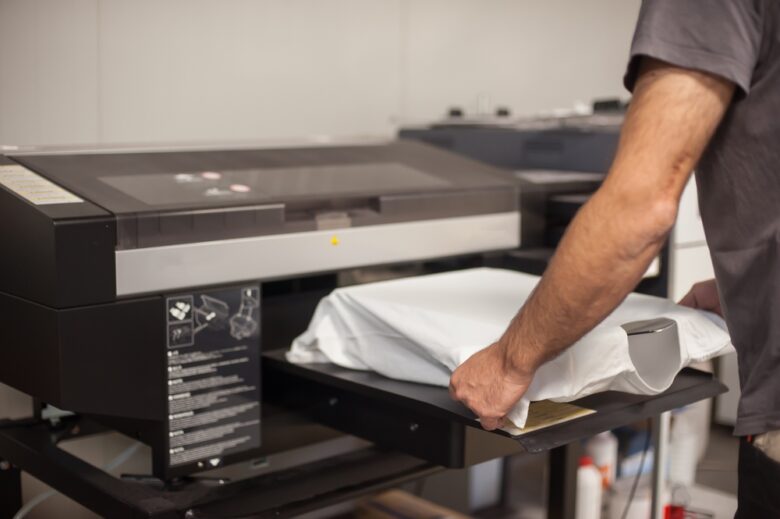Direct-to-garment (DTG) printing has revolutionized the world of custom apparel, allowing businesses and individuals to create high-quality, personalized clothing easily.
Whether you’re a beginner looking to delve into the world of DTG printing services or an experienced printer seeking to enhance your skills, this step-by-step guide will provide valuable insights and techniques to master the art of DTG printing.
Following these steps will help you achieve excellent print results and ensure customer satisfaction:
Contents
Preparing the Design
Preparing your design properly is crucial before you begin the DTG printing process. Start by choosing a high-resolution image or vector file accurately representing your desired design.
Ensure the image is in CMYK color mode and has a resolution of at least 300 dpi for optimal print quality. Remember to size your design appropriately to fit the garment you’ll print.
Next, use DTG-compatible software to adjust and optimize your design for printing. This software allows you to make necessary modifications, such as resizing, rotating, or adding text, ensuring that your design looks its best on the garment.
Remember to save the file in a compatible format, such as PNG, to maintain transparency and preserve the quality of the design.

Preparing the Garment
Properly preparing the garment is vital to ensure a successful DTG printing process. Select the appropriate fabric for your desired design and consider color, texture, and composition factors.
Choosing fabrics compatible with DTG printing is important, as certain materials may not yield optimal results. Consult with your DTG printing service or refer to their guidelines for fabric compatibility.
Next, pre-treat the garment to enhance ink absorption and improve color vibrancy. Pre-treatment involves applying a specialized solution to the fabric, allowing the ink to bond effectively.
Follow the DTG printer manufacturer’s instructions or refer to their guidelines for the appropriate pre-treatment process and solution. Proper pre-treatment ensures that your design looks vibrant and will last long on the garment.
Setting Up the DTG Printer
Setting up your DTG printer correctly is essential to achieve the best print results. Begin by ensuring the printer is clean and free from debris or residual ink. Regularly clean the print heads and maintain the printer according to the manufacturer’s instructions to prolong its lifespan and maintain print quality.
Next, load the appropriate ink cartridges into the printer. DTG printers typically use CMYK ink cartridges and white ink to print dark-colored garments. Make sure the ink cartridges are securely inserted and properly aligned.

Source: gelato.com
Printing the Design
With your design prepared, your garment pre-treated, and your printer set up, it’s time to print your design using the DTG printer. Follow these steps to ensure a successful printing process:
- Position the garment on the DTG printer’s platen or print bed, ensuring it’s flat and taut.
- Select the appropriate print settings in the DTG printer software, such as print resolution and color profile.
- Load the pre-treated garment onto the platen, aligning it accurately with the print area.
- Send the print command to the DTG printer and wait for the printing process to complete.
- Once the printing is finished, remove the garment from the printer and inspect the print quality.
Ensure the print is sharp, vibrant, and free from defects or smudges, making any necessary adjustments or reprints.
Curing and Finishing the Printed Garment
Once you’ve successfully printed the design onto the garment, it’s essential to cure and finish the print to ensure its longevity and durability. Curing involves using heat to bond the ink to the fabric, ensuring it withstands regular wear and washing.
Follow these steps to cure and finish the printed garment properly:

Source: thefashionstarter.com
Heat Press
Place the printed garment on a heat press machine, ensuring the design faces upwards. Set the temperature and time according to the manufacturer’s recommendations and press the garment using firm pressure. This process helps the ink to cure and adhere to the fabric fully.
Post-Treatment
After curing, some DTG prints may require post-treatment to enhance their washability and color fastness. This step typically involves using a post-treatment solution or heat press to bond the ink further and improve the overall durability of the print. Follow your DTG printing service’s instructions or refer to their guidelines for the appropriate post-treatment process.
Quality Inspection
Once the curing and finishing process is done, carefully inspect the printed garment for any imperfections, color inconsistencies, or other issues. This step allows you to identify and address potential flaws before delivering the final product to your customers. Correct any issues and reprint if necessary to maintain the highest quality standards.
After completing the quality inspection, ensure that the cured and finished garment has a smooth texture, vibrant colors, and excellent overall print quality, providing your customers with a professional and visually appealing final product.

Source: printful.com
Troubleshooting Common Issues
Even with proper preparation and maintenance, you may encounter occasional issues during the DTG printing process. Here are some common problems and their potential solutions:
- Blurry or Fuzzy Prints: Check the resolution of your design file and ensure that it’s high enough for optimal print quality. Additionally, ensure the garment is positioned correctly on the printer’s platen to avoid movement during printing.
- Ink Bleeding or Smudging: Adjust the printer software’s ink saturation and drying settings to prevent excessive ink absorption or insufficient drying time. Also, ensure the garment is properly pre-treated to improve ink absorption and reduce bleeding.
- Color Inconsistencies: Calibrate your printer regularly to maintain accurate color reproduction. Additionally, ensure that your design file is in the CMYK color mode and that the printer’s color profiles are correctly set.
If you continue to experience blurry or fuzzy prints, ink bleeding or smudging, or color inconsistencies, don’t hesitate to troubleshoot your printer or seek assistance from a qualified technician to address the problem effectively.
Proper Maintenance of the DTG Printer
Proper maintenance of your DTG printer is essential to ensure consistent print quality and extend its lifespan. Regularly cleaning the print heads using manufacturer-recommended cleaning solutions and techniques prevents clogs and ensures precise ink deposition during printing.
It’s important to monitor the ink levels in your cartridges and refill or replace them as needed to maintain ink during a print job, which can result in incomplete prints or disruptions.
Periodically calibrating your DTG printer is crucial to maintain accurate color reproduction and alignment. Follow the calibration procedures provided by the manufacturer or consult the user manual for detailed instructions.

Source: theprintways.com
Conclusion
Mastering the art of DTG printing requires attention to detail and adherence to specific techniques. By following the step-by-step guide outlined above, beginners can gain valuable insights into the process, ensuring optimal print results and customer satisfaction.
With practice and dedication, you can unlock the full potential of DTG printing and create stunning, personalized apparel for your business or brand. For more in-depth insights and practical tips on mastering the technique of DTG printing, click here to access a valuable resource that explores the power of DTG printing and provides expert guidance in achieving exceptional results.
